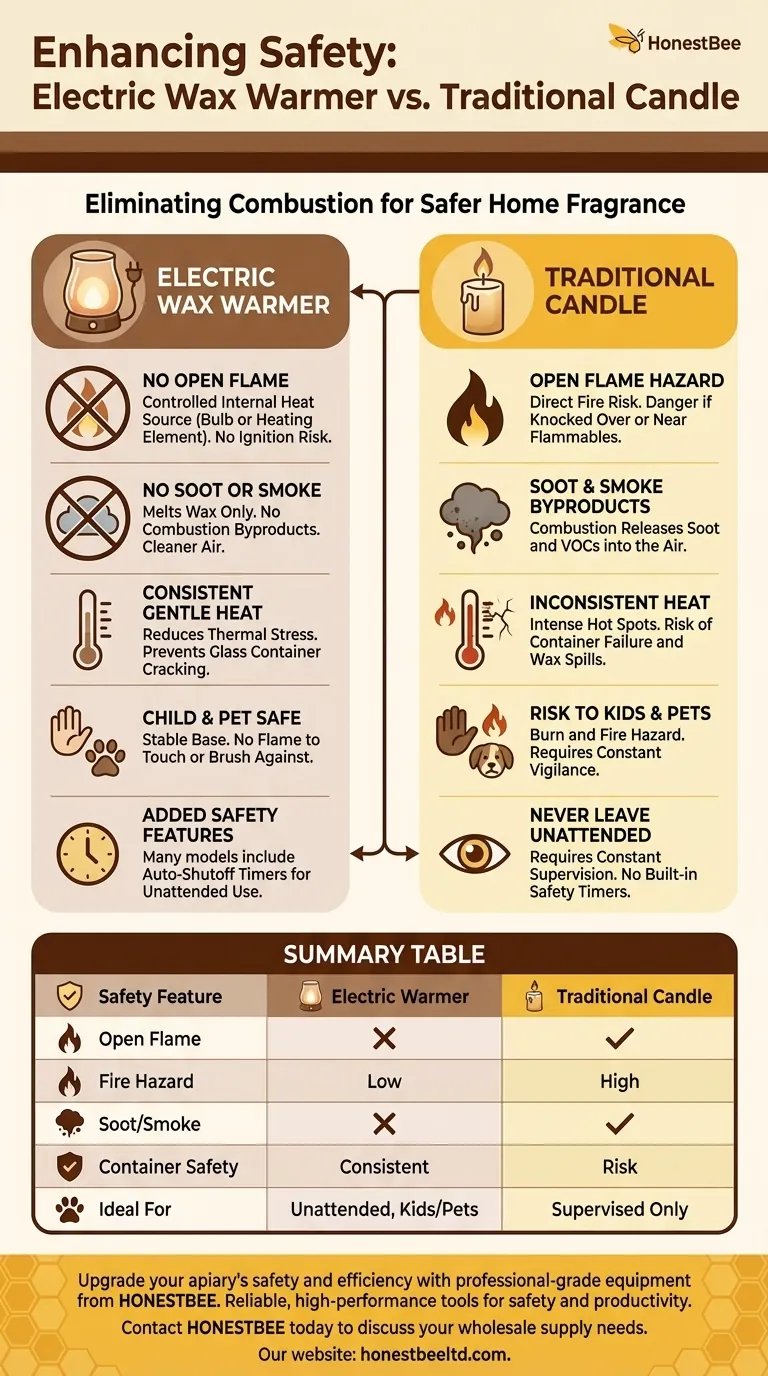The fundamental safety advantage of an electric wax warmer lies in its complete elimination of an open flame. Unlike traditional candles which rely on combustion, electric warmers use a controlled internal heat source, such as a low-wattage bulb or a ceramic heating element. This design inherently removes the primary risks of fire, smoke, and soot associated with a burning wick.
By replacing combustion with a controlled heating element, electric wax warmers remove the unpredictable dangers of an open flame, offering a fundamentally safer and cleaner method for enjoying home fragrance.

The Core Safety Principle: Eliminating Combustion
The primary distinction between a candle and an electric warmer is the method of heat delivery. Understanding this difference is key to appreciating the safety implications.
The Inherent Risk of an Open Flame
A traditional candle is, by definition, an open flame. This presents a direct fire hazard if the candle is knocked over or placed too close to flammable materials like curtains, bedding, or paper.
Electric warmers have a stable base and no flame, completely mitigating the risk of accidental ignition.
The Danger of Soot and Smoke
Burning a candle wick results in combustion, a chemical process that releases byproducts into the air. This includes soot (fine black particles) and other volatile organic compounds.
Because electric warmers only melt the wax, they release fragrance without creating the harmful byproducts of burning. This results in a cleaner air environment.
Inconsistent Heat and Glass Integrity
A candle's flame can create intense, localized hot spots on its glass container. This thermal stress can, in some cases, cause the glass to crack or even shatter, spilling hot wax and posing a significant hazard.
Electric warmers apply gentle, consistent heat across a wider surface, drastically reducing the risk of container failure.
Designed for Household Safety
Beyond simply removing the flame, electric warmers incorporate design features specifically aimed at safe, unattended use in a modern home.
Stable, Low-Temperature Operation
Most electric warmers operate at temperatures just high enough to melt wax effectively. This is typically well below the flashpoint of most materials, making them exceptionally stable. The heat source is contained, and the exterior of the unit generally remains safe to touch, though the warming plate or dish will be hot.
Reduced Risk for Children and Pets
The absence of a flame is a critical safety feature in households with curious children or active pets. There is no risk of a child touching a flame or a pet's tail catching fire by brushing past.
Features for Peace of Mind
Many modern electric warmers include additional safety features, such as an automatic shut-off timer. This allows you to set the device to turn off after a designated period, providing confidence that it won't be left on indefinitely.
Understanding the Nuances and Trade-offs
While demonstrably safer, it's important to approach electric warmers with a clear understanding of their own safety considerations.
Electrical Safety Is Still a Factor
As with any electrical appliance, it is crucial to use products that are certified by a recognized safety organization (like UL). Always ensure the cord is not frayed or damaged and never place the warmer near water.
Hot Wax Remains a Mild Concern
The melted wax in the warmer's dish can still be hot enough to cause a minor burn if spilled. It should be placed on a stable surface where it is unlikely to be knocked over. However, this risk is significantly lower than that of an open flame and spilled candle wax.
Making the Right Choice for Your Home
Your final decision should be based on your specific household environment and safety priorities.
- If your primary focus is fire prevention, especially with children or pets: The electric warmer is the definitive choice, as it completely removes the risk of an open flame.
- If your primary focus is indoor air quality: An electric warmer is the superior option because it releases fragrance without the soot and combustion byproducts of a burning wick.
- If you want to enjoy fragrance for long, unattended periods: An electric warmer, particularly one with an auto-shutoff timer, offers a level of safety that a candle can never match.
By shifting from combustion to a controlled heating element, you are fundamentally upgrading the safety of your home fragrance system.
Summary Table:
| Safety Feature | Electric Wax Warmer | Traditional Candle |
|---|---|---|
| Open Flame | No | Yes |
| Fire Hazard | Significantly Reduced | High |
| Soot/Smoke | No | Yes |
| Container Safety | Consistent, gentle heat | Risk of cracking from hot spots |
| Ideal For | Homes with kids/pets, unattended use | Supervised use only |
Upgrade your apiary's safety and efficiency with professional-grade equipment from HONESTBEE.
Just as an electric wax warmer provides a safer, more controlled way to enjoy fragrance, HONESTBEE supplies commercial apiaries and beekeeping equipment distributors with reliable, high-performance tools designed for safety and productivity. From smokers to hive tools, our wholesale-focused operations ensure you get the durable equipment you need.
Contact HONESTBEE today to discuss your wholesale supply needs and enhance your beekeeping operations.
Visual Guide

Related Products
- Professional Stainless Steel Wax Melter for Beekeeping and Crafts
- Beeswax Melter for Candle Making Honey Bee Wax Melter
- Honey Wax Separating Wax Press with Metal Screw Wax Separator Machine
- Steam Beeswax Melter Wax Warmer for Wax Processing
- Electric Honey Press Machine for Squeezing Honey Comb Press Equipment
People Also Ask
- What temperature range is considered gentle heat for melting beeswax? Preserve Aroma & Color
- What are wax melters used for? Unlock Efficient Wax Processing for Your Business
- What is the flash point of beeswax, and why is it important? Essential Safety Guide for Beekeepers
- What are the safety precautions when working with melted beeswax? Prevent Burns and Fire Hazards
- Can I melt beeswax in a wax melter? The Key to Safe, High-Quality Results



















